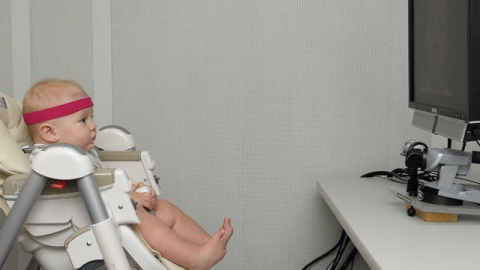What Do Infants See?
- Insight uOttawa
- Feb 20, 2021
- 4 min read
Updated: Oct 8, 2021
Child Development has become a vast and intriguing field of psychology. The integration of vision science and health within infant psychology is what made Child Development one of my favourite courses at uOttawa. Highly recommended! Research surrounding infants’ visual capabilities is ongoing and investigators have established very unique methods of communicating with infants who often cannot communicate with us.
Babies are able to sense visual stimuli as early as at four months of pregnancy, yes while they are still in the womb! Studies have shown that changes in brightness elicits a pupillary reflex in neonates, indicating sensitivity to light. Nonetheless, newborn babies are born with an immature visual acuity and have fairly poor vision. Although sensitivity to visual stimuli occurs in the womb, rapid development of the visual system does not occur until 6 months of age. Newborns limited and poor visual acuity make their sense of the world very different from that of adults. Refer to the image below to see how vision changes at different points in infant development into adulthood:

Figure 1.
Facial recognition is one of, if not the most important aspect of infant perception. This happens at about 2 to 3 months of age where babies will use outer contours and facial features to recognize faces, most often that of their mothers. Photographic eye movements, and other methods of eye tracking at different ages provide insight into cognitive development as well as preferences in visual stimuli. In a paper by Sam Wass, the use of eye tracking with infants and children occurs in two ways: screen based tasks, in which viewing material are presented on a computer monitor, or naturalistic observation.
However, improvements in technology continue to provide scientists more effective ways to measure infant visual perception.
Researchers at the Beckman Institute for Advanced Science and Technology and the University of Illinois have successfully used infrared eye tracking technology to measure looking behavior in infants. Researchers wrote that the “study demonstrates that eye tracking technology can be used to automate assessments of infant looking behaviors that measure specific cognitive domains such as processing, attention, social cognition and recognition memory.” (Dźwilewski et al. 2020)
Researchers used an Eyelink 1000 Plus infrared eye tracker to record infants’, of 7-8 months, gaze during visual recognition tasks using faces and shapes on screens.Babies will wear target stickers on their foreheads and the eye tracker will measure the distance between the sticker and their cornea. Refer to the image below exhibiting the process of using eye tracking technology in infant development research.
Figure 2a Figure 2b
Figure 2a. https://bergelsonlab.com/images/eyelink.jpg
Figure 2b. https://scholars.direct/Articles/cognitive-science/acs-2-010-002.jpg
The findings of the study were in line with previous studies: infants tend to spend a longer time looking at stimuli that are novel. This tendency is often explained as an inborn trait; at birth the human babies are set up to sense novelty, or things that are new, in their environment. Call it a survival instinct!
The ability neonates possess to recognize faces, within hours of birth, has formed the basis of most research in this field. Further studies aim to explain why babies are so drawn to faces so early in life, and what implications are posed in terms of cognitive and behavioral development further in life. Psychologists at Emory University published their findings in the Proceedings of the National Academy of Sciences. U sing harmless functional magnetic resonance imaging they were able to provide insight into the structure and function of newborns' visual cortex.
The premise of the study was that if the face network in the baby's visual cortex was not well connected, that may be an indication of potential disorders with aversion of eye contact. Use of such studies can be important in detecting problems earlier in life. The fMRI was performed using a large magnet to scan the body and record signals and properties of blood flow, giving scientists the ability to detect which areas of the brain are activated. Results showed two regions of the visual cortex associated with face recognition were active, similar but not identical to that of adults. Refer to the following article to read more about this study: https://www.sciencedaily.com/releases/2020/03/200302200736.htm
The image below shows fMRI scans of areas of the brain involved in facial recognition from 6 months of age to adulthood:

Figure 3. https://mcgovern.mit.edu/wp-content/uploads/2018/08/gr1_lrg-2.jpg
As you can see infant brains are not all that different from adult brains as we thought...I think we can agree that the study of what infants see is an intriguing area of research. This post is just a part of the vast information and research surrounding visual perception and development in infants!
References
Dźwilewski, K. L. C., Merced-Nieves, F. M., Aguiar, A., Korrick, S. A., & Schantz, S. L. (2020).
Characterization of performance on an automated visual recognition memory task in
7.5-month-old infants. Neurotoxicology and Teratology, 81, [106904].
Emory Health Sciences. "Earliest look at newborns' visual cortex reveals the minds babies
start with." ScienceDaily. ScienceDaily, 2 March 2020. <
Hyvärinen, Lea et al. “Current Understanding of What Infants See.” Current ophthalmology
reports vol. 2,4 (2014): 142-149. doi:10.1007/s40135-014-0056-2
Scientists Use Eye Tracking Technology to Automate an Important Visual Recognition
Memory Test for Infants.” PsyPost, 21 Aug. 2020, www.psypost.org/2020/08/scientists-
use-eye-tracking-technology-to-automate-an-important-visual-recog nition-memory-
test-for-infants-57758










Comments